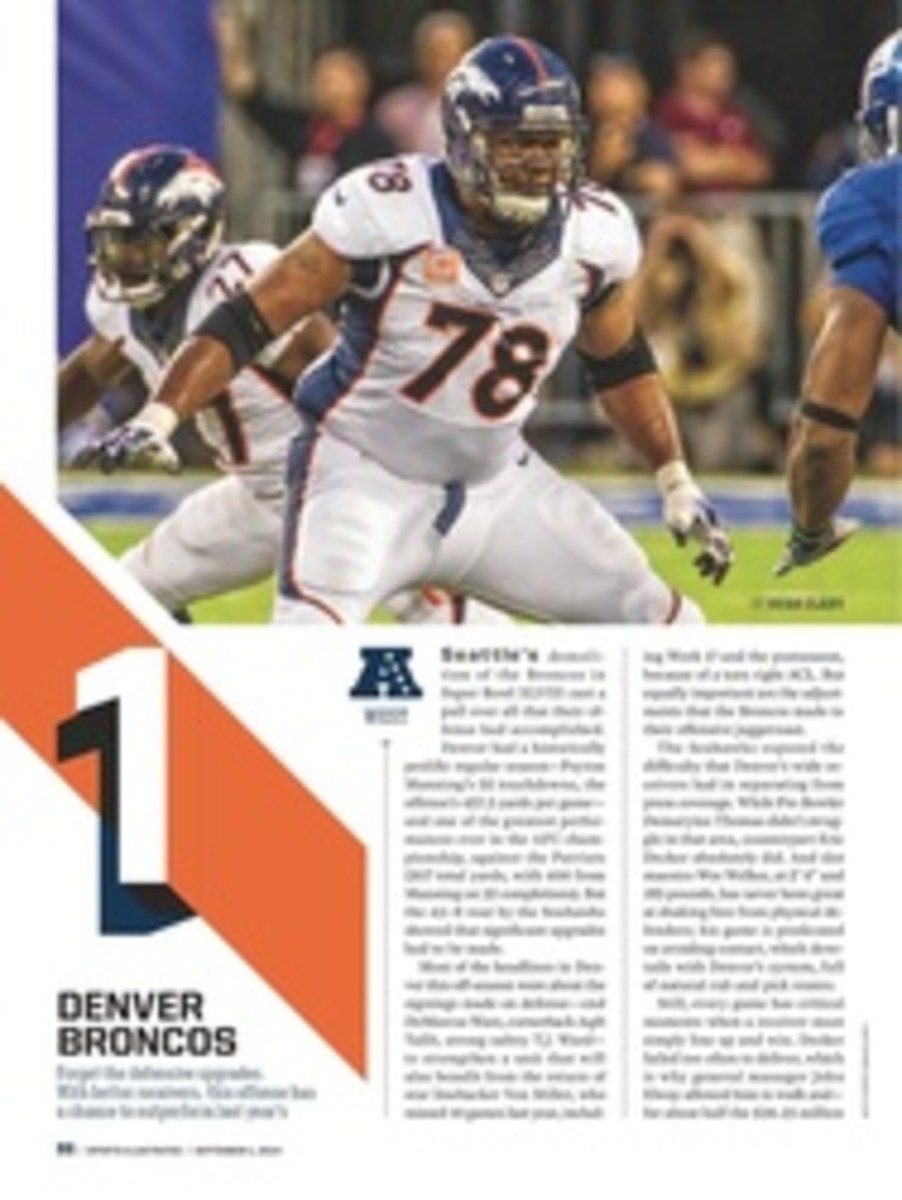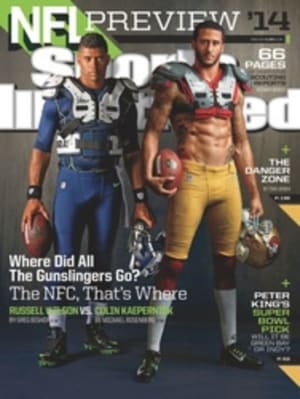
1 BALTIMORE RAVENS
The Ravens have long been built around their defense—but it's important to think about what kind of defense it's been. Historically, the NFL's great D's have had distinct identities. For example, the 2013 Seahawks, with their lanky corners and speedy linebackers, were designed to win on the perimeter. The '02 Buccaneers, with their gap-shooting defensive linemen and fast linebackers, dominated with downhill playmaking.
Baltimore, for the longest time, has been built to win in the middle of the field, where inside linebacker Ray Lewis roamed, and where its most feared player, free safety Ed Reed, patrolled the hashmarks. The Ravens' front line was led by a succession of behemoth defensive tackles—Sam Adams, Tony Siragusa and, most recently, 2006 first-round pick Haloti Ngata, who is still a star.
But one of the best-kept secrets in football is that this vaunted defense, particularly its interior, started decaying even before Lewis and Reed left. Baltimore's 2012 Super Bowl run was spearheaded by Joe Flacco and the offense. In four playoff wins the Ravens' D surrendered an average of 22 points; it was big plays and 31 points per game by the offense that propelled the team to the Lombardi Trophy.
In 2014 the middle could become this defense's weakest spot—not for a lack of talent but for a lack of experience. At Lewis's old position, free-agent pickup Daryl Smith was a sensational all-around player last year, but he'll work alongside either first-round rookie C.J. Mosley (Alabama) or last year's second-rounder, Arthur Brown, who has come along slowly and who appears destined to play only on passing downs. Mosley might prove to be an every-down force, but he'd be the first rookie to accomplish that immediately in Baltimore's complicated multifront scheme.
Behind the linebackers, last year's first-round pick, strong safety Matt Elam, will play both in the box and in the middle, deep. Elam plays big and moves well, but he has gone through a steep learning curve. Now he'll be asked to be a leader for fellow safety Terrence Brooks, who has been competing with veteran pickup Darian Stewart for playing time. In the middle up front, the hope is that untested second-year pro Brandon Williams and enigmatic fifth-year man Terrence Cody can handle the all-important nosetackle duties, which would allow Ngata to once again move around, lining up over guards and tackles.
So this is the Ravens' defense today: Coach John Harbaugh and coordinator Dean Pees have to hope that their stars and depth on the outside can compensate for their uncertain middle. While Baltimore lost budding end Arthur Jones to the Colts, consistently disruptive veteran Chris Canty and intriguing inside pass rusher Pernell McPhee can fill that void. There's also second-round rookie Timmy Jernigan (Florida State), though he may be here to sit and learn before ultimately replacing Ngata, who even at 30 is still in his prime but has been bothered by injuries in recent years.
On the edges Terrell Suggs is still a disruptive rusher and an even more fearsome run defender. Elvis Dumervil has so far given a good return on GM Ozzie Newsome's five-year, $26 million investment. And there's Courtney Upshaw, an up-and-coming five-tool player who can cover in the flats as well as rush the passer. He's also very successful at laterally sifting through run blockers.
And in the secondary, Harbaugh and his staff believe enough in fourth-year corner Jimmy Smith to swap a portion of their matchup-zone concepts for more press-man coverage. The long-armed Smith is a very effective jammer along the boundary, and he has improved his technique when the ball is in the air. On the other side, Lardarius Webb missed most of training camp with a back injury—this after tearing his left ACL in 2012. If healthy, Webb is one of the league's better man-to-man slot artists and a tremendous outside deep-ball defender.
Both corners will have to survive in plenty of Cover Zero (that is, true one-on-one) because most of the help will be dedicated to aiding the oft-overmatched Chykie Brown or untested Asa Jackson, one of whom will assume the nickel duties with Corey Graham now in Buffalo.
Perhaps the easiest explanation for how the Ravens' defensive decline has gone overlooked is that they finally have an offense capable of making up the difference. And that remains the case: The signing of free-agent receiver Steve Smith and the installation of new coordinator Gary Kubiak's play-action system should give Flacco and his cohorts more opportunities to beat the man coverages that have so often stifled them. It's a passing game that, through practices, will challenge a rebuilt defense to find its new identity.
2014 SCHEDULE
2013 Record: 8--8
WEEK 1
CIN [HOME]
PIT THUR [HOME]
CLE [AWAY]
CAR [HOME]
IND [AWAY]
TB [AWAY]
ATL [HOME]
CIN [AWAY]
PIT [AWAY]
TEN [HOME]
BYE
NO MON[AWAY]
SD [HOME]
MIA [AWAY]
JAX [HOME]
HOU [AWAY]
CLE [HOME]
WEEK 17
FOCUS ON
The backfield
The Ravens had the third-worst rushing attack in the NFL last season. Ray Rice gained 3.1 yards per carry, backup Bernard Pierce averaged 2.9, and both men looked like 30-year-olds hitting the notorious running back wall. Except that Rice was 26 and Pierce 23. So how can they turn things around? Rice, who will first serve a two-game suspension for a domestic violence incident, must recapture his short-area east-west burst. An important factor will be his relationship with the blocking scheme. New offensive coordinator Gary Kubiak will implement a zone system similar to what Rice has spent his career running behind. There's a key difference, though: To set up the system's hallmark rollouts and play-action crossing patterns, Kubiak will call more stretch runs to the outside. And Pierce may actually be the better runner in this sense. While not as fast or quick as Rice, he's always had an innate sense for moving forward along the perimeter.
THE CASE FOR
Receiver Steve Smith
For immediate impact, the 35-year-old Smith was the best free-agent signing of 2014. His speed hasn't declined, and he's always been skilled at outmuscling and outpositioning defenders to make catches. The Ravens got him for a reasonable price (three years, $10.5 million), and he resolves what had been their receivers' most glaring issue: an inability to get open against man coverage. Torrey Smith is an undeniable deep threat, but he's merely average on routes that don't call for straight-line speed. That's problematic if he's Baltimore's No. 1 target; not so much if he's the No. 2. The rest of the receivers will now come off the bench because new coordinator Gary Kubiak prefers a two-tight-end base over the three-wideout package Baltimore ran in 2013. Filling those tight end spots are Dennis Pitta and Owen Daniels, two fluid movers who can catch balls away from their bodies. If everyone stays healthy, this will be the best collection of targets that Joe Flacco has had—all because of the arrival of one still-dangerous 35-year-old.
PHOTO
KARL MERTON FERRON/BALTIMORE SUN/MCT/LANDOV
ILB DARYL SMITH
PHOTO
GREG NELSON FOR SPORTS ILLUSTRATED
NINTEEN PHOTOS

